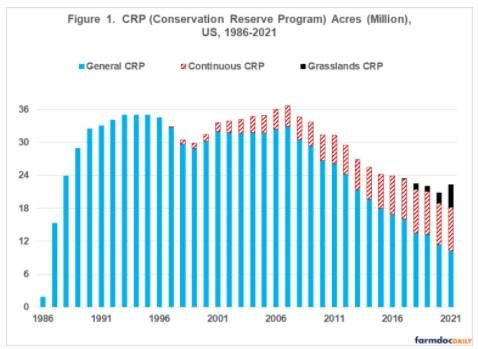By Carl Zulauf
Department of Agricultural, Environmental and Development Economics
Ohio State University
Nick Paulson and Krista Swanson et.al
Department of Agricultural and Consumer Economics
University of Illinois
This article examines the on-going reorientation of the Conservation Reserve Program (CRP). Its historic focus has been the removal of whole fields and farms from production, both to reduce crop output and attain conservation benefits. However, in 2021, CRP increased its focus on working farmland, particularly its grassland component. A working farmland environmental program enhances environmental performance of land that largely remains in farm production. Moreover, CRP’s continuous component can also be viewed in part as a working farmland program. Continuous CRP couples environmentally beneficial farm practices to a specific site. The site can be a sub-field area with the rest of the field remaining in production. Evolution of CRP toward a working farmland program may well continue given high commodity prices and environmental benefits associated with the various CRP components.
CRP History
CRP is currently a portfolio composed of General CRP, Continuous CRP, and Grassland CRP. General CRP retires cropland from production for, most commonly, 10 – 15 years. Its focus is whole fields and farms. General CRP dates to the creation of CRP by the 1985 farm bill. It remained the only CRP program until Continuous CRP was created administratively in September 1996 under general CRP program authority. On October 31, 2021, General CRP acres were 10.3 million, 71% below its peak of 35 million acres in 1995 (see Figure 1). The decline was due in part to a reduction in authorized maximum acres in CRP and in part to market returns from crop production. CRP enrollment data used in this article and Figure 1 are from US Department of Agriculture Farm Service Agency (USDA FSA), February 2022a and February 2022b.

Continuous CRP has the same land eligibility requirements as General CRP, but is not focused on whole farms or fields. It targets the most environmentally beneficial practices and areas of a field, such as wetlands, filter strips, riparian buffers, and wildlife habitats. Continuous CRP had 7.9 million acres in 2021, slightly below its 2018 peak of 8.0 million.
Grassland CRP allows continued grazing of land while enhancing environmental benefits, such as plant and animal diversity, as well as protecting grasslands, particularly virgin grasslands. It was authorized by the 2014 farm bill as part of a reconfiguration of Conservation title programs that included folding GRP (Grassland Reserve Program) into CRP. GRP was first authorized in the 2002 farm bill as a separate program. It was one component of increased emphasis in the 2002 farm bill on environmental performance of working farmland that included more funding for the Environmental Quality Incentives Program (EQIP) and creation of the Conservation Security Program (CSP).
During the 2020-21 program year Grassland CRP acres more than doubled from 1.8 million to a new high of 4.1 million acres (farmdoc daily October 25, 2021). Establishment of a minimum Grassland CRP rental rate of $15/acre was likely one factor (USDA FSA, June 2021). Over 70% of US non-forest pasture land reported in the 2017 Census of Agriculture (USDA National Agricultural Statistics Service (NASS), April 2019) were in states with an average pasture rental rate of under $15/acre (USDA NASS, February 2022).
Total CRP acres on October 31, 2021 were 22.3 million, with 46%, 36%, and 18% in General, Continuous, and Grassland CRP, respectively. This was the first time General CRP accounted for less than 50% of CRP acres. The previous low was 55% on October 31, 2020. Total CRP acres were 39% below the 2007 peak of 36.7 million. For further description of the three CRP programs, see the appendix in the October 25, 2021 farmdoc daily article.
Summary Observations
CRP, which was initially authorized during the farm financial crisis of the 1980s, began as a land retirement program with an environmental component. Over time, it has evolved more toward a working farmland program. Grassland CRP is labelled a working land program in its 2021 factsheet (USDA, FSA July 2021). Continuous CRP can also be viewed in part as a working farmland program. Continuous CRP couples environmentally beneficial farm practices to a specific site. The site can be a sub-field area with the rest of the field remaining in production. Over half of CRP acres are now in Continuous and Grassland CRP.
Given the current profitability of crop production, it is not unreasonable to expect continued decline in General CRP acres as at least some of these acres return to crop production at contract expiration. Negative environmental impacts can be minimized by using incentives to shift the most environmentally sensitive areas of General CRP fields and farms to Continuous CRP.
While not definitive, research suggests sequestration of carbon by pastureland can be increased (Conant, et al., 2017; and Paustian, et al., 2019). Given the current profitability of crop production and the over 400 million acres of non-forested grazing land in the US (USDA, NASS, April 2019), it is not unreasonable to expect that Grassland CRP could become a central focus of agriculturally generated carbon sequestration.
Source : illinois.edu